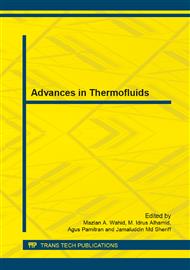[1]
A. Epstein and S. Senturia, Macro power from micro machinery, Science-New York Then Washington-, pp.1211-1211, (1997).
DOI: 10.1126/science.276.5316.1211
Google Scholar
[2]
A. Mehra and I. Waitz, Development of a hydrogen combustor for a microfabricated gas turbine engine, in Solid-State Sensor and Actuator Workshop, Hilton Head Island, SC, (1998).
DOI: 10.31438/trf.hh1998.9
Google Scholar
[3]
A. C. Fernandez-Pello, Micropower generation using combustion: issues and approaches, Proceedings of the Combustion Institute, vol. 29, pp.883-899, (2002).
DOI: 10.1016/s1540-7489(02)80113-4
Google Scholar
[4]
J. Hua, M. Wu, and K. Kumar, Numerical simulation of the combustion of hydrogen–air mixture in micro-scaled chambers part II: CFD analysis for a micro-combustor, Chemical engineering science, vol. 60, pp.3507-3515, (2005).
DOI: 10.1016/j.ces.2005.01.042
Google Scholar
[5]
J. Hua, M. Wu, and K. Kumar, Numerical simulation of the combustion of hydrogen–air mixture in micro-scaled chambers. Part I: Fundamental study, Chemical engineering science, vol. 60, pp.3497-3506, (2005).
DOI: 10.1016/j.ces.2005.01.041
Google Scholar
[6]
J. Zarvandi, S. Tabejamaat, and M. Baigmohammadi, Numerical study of the effects of heat transfer methods on CH4/(CH4+ H2)-AIR pre-mixed flames in a micro-stepped tube, Energy, vol. 44, pp.396-409, (2012).
DOI: 10.1016/j.energy.2012.06.015
Google Scholar
[7]
S. E. Hosseini and Mazlan A. Wahid, Feasibility study of biogas production and utilization as a source of renewable energy in Malaysia, Renewable and Sustainable Energy Reviews, vol. 19, pp.454-462, (2013).
DOI: 10.1016/j.rser.2012.11.008
Google Scholar
[8]
J. Park, K. T. Kim, J. S. Park, J. S. Kim, S. Kim, and T. K. Kim, A study on H2-Air counterflow flames in highly preheated air diluted with CO2, Energy & fuels, vol. 19, pp.2254-2260, (2005).
DOI: 10.1021/ef050152l
Google Scholar
[9]
C. Cohé, C. Chauveau, I. Gökalp, and D. F. Kurtuluş, CO2 addition and pressure effects on laminar and turbulent lean premixed CH4 air flames, Proceedings of the Combustion Institute, vol. 32, pp.1803-1810, (2009).
DOI: 10.1016/j.proci.2008.06.181
Google Scholar
[10]
S. H. Kim and J. A. Edmonds, Potential for advanced carbon capture and sequestration technologies in a climate constrained world: Pacific Northwest National Laboratory, (2000).
DOI: 10.2172/968483
Google Scholar
[11]
S. E. Hosseini and Mazlan A. Wahid, Necessity of biodiesel utilization as a source of renewable energy in Malaysia, Renewable and Sustainable Energy Reviews, vol. 16, pp.5732-5740, (2012).
DOI: 10.1016/j.rser.2012.05.025
Google Scholar
[12]
D. G. Norton and D. G. Vlachos, A CFD study of propane/air microflame stability Combustion and Flame, vol. 138, pp.97-107, (2004).
DOI: 10.1016/j.combustflame.2004.04.004
Google Scholar
[13]
D. G. Norton and D. G. Vlachos, Combustion characteristics and flame stability at the microscale: a CFD study of premixed methane/air mixtures, Chemical engineering science, vol. 58, pp.4871-4882, (2003).
DOI: 10.1016/j.ces.2002.12.005
Google Scholar
[14]
J. Li, S. Chou, W. Yang, and Z. Li, A numerical study on premixed micro-combustion of CH4–air mixture: Effects of combustor size, geometry and boundary conditions on flame temperature, Chemical engineering journal, vol. 150, pp.213-222, (2009).
DOI: 10.1016/j.cej.2009.02.015
Google Scholar
[15]
K. M. Saqr, H. S. Aly, M. M. Sies, and Mazlan A. Wahid, Effect of free stream turbulence on NOx and soot formation in turbulent diffusion CH4-air flames, International Communications in Heat and Mass Transfer, vol. 37, pp.611-617, (2010).
DOI: 10.1016/j.icheatmasstransfer.2010.02.008
Google Scholar
[16]
B. Xu and Y. Ju, Concentration slip and its impact on heterogeneous combustion in a micro scale chemical reactor, Chemical engineering science, vol. 60, pp.3561-3572, (2005).
DOI: 10.1016/j.ces.2005.01.022
Google Scholar
[17]
F. Williams, (1985) Combustion Theory, Benjamin/Cummings, Menlo Park, CA.
Google Scholar
[18]
T. T. Leach and C. P. Cadou, The role of structural heat exchange and heat loss in the design of efficient silicon micro-combustors, Proceedings of the Combustion Institute, vol. 30, pp.2437-2444, (2005).
DOI: 10.1016/j.proci.2004.08.229
Google Scholar
[19]
K. Maruta, T. Kataoka, N. I. Kim, S. Minaev, and R. Fursenko, Characteristics of combustion in a narrow channel with a temperature gradient, Proceedings of the Combustion Institute, vol. 30, pp.2429-2436, (2005).
DOI: 10.1016/j.proci.2004.08.245
Google Scholar


